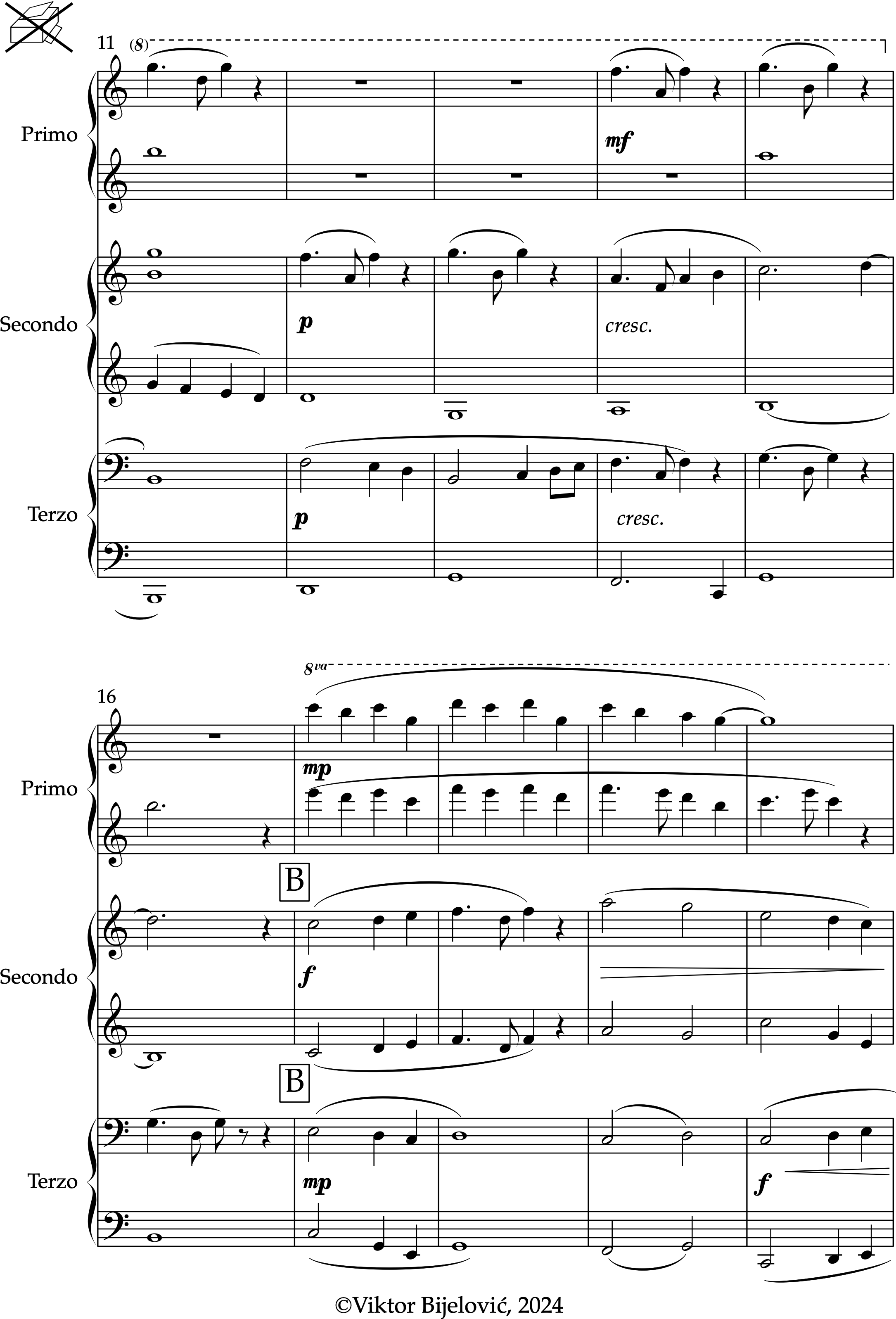 Image 1 of 5
Image 1 of 5

 Image 2 of 5
Image 2 of 5

 Image 3 of 5
Image 3 of 5

 Image 4 of 5
Image 4 of 5

 Image 5 of 5
Image 5 of 5






DIGITAL DOWNLOAD Viktor Bijelović - 3 pieces for 6 hands at the piano, Op. 11, Book 2 (of 2)
6 Hands at one piano - 33% discount when buying the whole book
THIS IS A DIGITAL DOWNLOAD
Physical Book (printed score) option available for only £4 extra + shipping.
Book 2
Op. 11 No. 4 - "Vertical Waves" relies on the rhythm of the first 3 notes to convey the sound of sussurating waves. The tempi change several times, so the trick here is to do it in a way that feels organic. Also, almost the entire range of the piano is used, so the Primo part should pay particular attention to the octave(s) higher signs.
Op. 11 No. 5 - "Summer Stroll" is all about dotted rhythms, so it's best to count in quavers. The last quaver of the bar also gives the melody motion, moving the listener towards the first beat of next bar. There are some duplets, for example in bar 56, where the second note must always be played quieter. Lastly, Terzo gets to play several solo sections, for a change. Enjoy them and play out!
Op. 11 No. 6 - "Beginnings" aims to helpstudents explore different kinds of touch. Martellato is the Italian word for hammered and calls for a bright, forceful sound, from on top of the key. There must be some give in the wrist to prevent the sound from becoming harsh; it should only be bright. Pay special attention to bar 21 where the Primo part has an octave higher clef change until the end. It also gets the students using the entire range of the piano.
These pieces are written with teachers in mind, allowing players of different levels to appreciate the joys of piano chamber music. Many of the lines are doubled between the hands, giving the student and teacher the choice to play both or leave one out, for the sake of simplicity.
© Viktor Bijelović 2024
6 Hands at one piano - 33% discount when buying the whole book
THIS IS A DIGITAL DOWNLOAD
Physical Book (printed score) option available for only £4 extra + shipping.
Book 2
Op. 11 No. 4 - "Vertical Waves" relies on the rhythm of the first 3 notes to convey the sound of sussurating waves. The tempi change several times, so the trick here is to do it in a way that feels organic. Also, almost the entire range of the piano is used, so the Primo part should pay particular attention to the octave(s) higher signs.
Op. 11 No. 5 - "Summer Stroll" is all about dotted rhythms, so it's best to count in quavers. The last quaver of the bar also gives the melody motion, moving the listener towards the first beat of next bar. There are some duplets, for example in bar 56, where the second note must always be played quieter. Lastly, Terzo gets to play several solo sections, for a change. Enjoy them and play out!
Op. 11 No. 6 - "Beginnings" aims to helpstudents explore different kinds of touch. Martellato is the Italian word for hammered and calls for a bright, forceful sound, from on top of the key. There must be some give in the wrist to prevent the sound from becoming harsh; it should only be bright. Pay special attention to bar 21 where the Primo part has an octave higher clef change until the end. It also gets the students using the entire range of the piano.
These pieces are written with teachers in mind, allowing players of different levels to appreciate the joys of piano chamber music. Many of the lines are doubled between the hands, giving the student and teacher the choice to play both or leave one out, for the sake of simplicity.
© Viktor Bijelović 2024
























